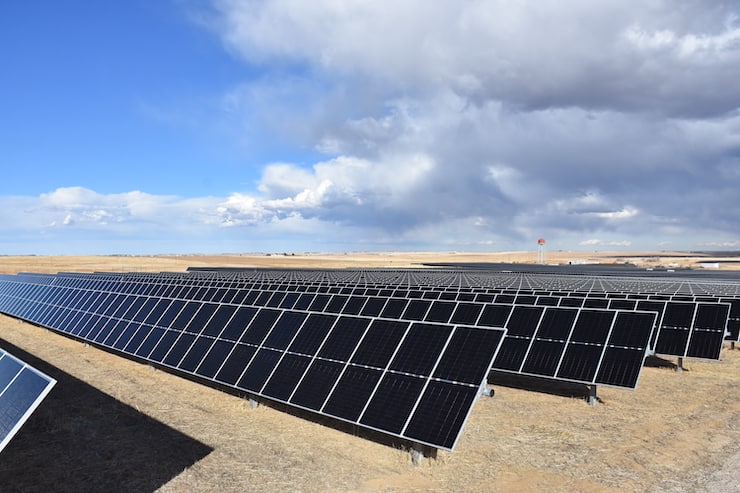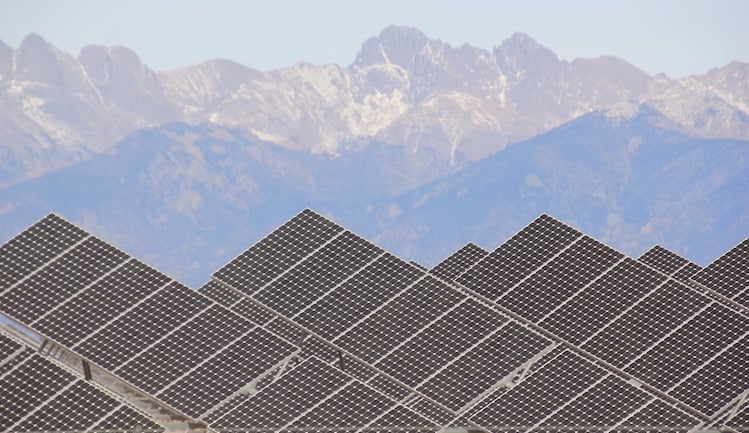Mike Kruger of the Colorado Solar and Storage Association explains why the big jump now and how storage has become an important component of the trade organization’s agenda.
by Allen Best
First, a question for you: What is your first reaction to seeing the chart below. Is it wow! Or had you already realized that this was coming, this break-out year for solar in Colorado?
When I talked with Mike Kruger, who directs Colorado Solar and Storage Association, he assured me that most readers of Big Pivots will not be surprised. Most saw it coming – and, in fact, had it not been for Covid and the supply disruptions, Colorado might have had its big leap during 2021.
The chart comes from the Solar Energy Industries Association report of March 2024. The report — which brims with interesting data — says nearly 40% of Colorado’s 4,112 megawatts of installed solar capacity was installed in 2023. And that Colorado is projected to gain another 2,835 megawatts of capacity in the next five years.

Screenshot
A full admission: I said wow, and I had been tracking this story since roughly 2016 – which is one place where this story starts. Xcel Energy that year began its electric resource planning cycle. It got bids late in 2017 and announced them just after Christmas. I remember seeing the e-mail distributed by Leslie Glustrom, an Xcel shareholder and watchdog. Wind, especially, but solar, too, had delivered jaw-dropping offers. In that instant it became apparent to me that coal would soon to be in our rear-view mirror.
The Colorado Public Utilities Commission approved Xcel’s plans for a deep investment in renewables in September 2018.
That November Jared Polis was elected Colorado governor after having campaigned on a platform of 100% renewables.
In early December, Xcel Energy announced it planned to achieve an 80% reduction in carbon emissions by 2030 as compared to 2005 levels. Platte River Power Authority announced an even more ambitious goal in December but one festooned with conditions. And by the next May, Colorado had a law that required Xcel and Black Hills Energy to attain 80% decarbonization by 2030.
Kruger had arrived in the midst of this sudden pivot to take the reins of what was then called the Colorado Solar Energy Industries Association. At the time, the staff consisted of Kruger and one other individual. The organization now has six staff members, suggestive of the growth of the solar industry in Colorado.
On a recent Friday, between an emergency discussion about legislative affairs and his next appointment, Kruger talked with Big Pivots for about 25 minutes about the context for this graph and the story that lies beyond.
Big Pivots: What explains this big jump in solar during 2023 in Colorado?
Mike Kruger: We’re finally seeing the fruits of some of our labors here to decarbonize stuff. The big jump is explained largely by Thunder Wolf and Neptune, Xcel’s two big solar projects in Pueblo County. Nearly 500 MWs of new solar and 125 megawatts of battery as well. All are for Xcel Energy. And then we have the projects of the electrical cooperatives, including the 80-megawatt project out by Bennett (east of Denver). Hunter. That power goes to CORE Electric Cooperative and …
Holy Cross Energy.
Yeah. The Hunter project came on in 2023. Multiple other smaller projects entered service in 2023, too.
We’re just seeing the fruits of the labor by COSSA and other advocacy groups to decarbonize. Neptune and Thunder Wolf were a result of the solicitation in 2017 that came online in 2023. So it takes time to build these things. Obviously, we have a pandemic between them, which pushed the timeline even further.
Now that they’ve been set up, these dominoes are going to start falling. We’re going to really see hundreds, if not thousands, of megawatts of solar added to the grid every year through the rest of the decade.
In 2019, when we passed our first decarbonization bill, we had a 15-gigawatt system in Colorado. That was our peak demand. 80% of that is around 12 gigawatts of demand. Through 2019, we had installed about 2 gigawatts of renewables, mostly wind.
So, to meet those decarbonization goals, you have to build a lot of solar farms. You have to put up a lot of wind turbines. For the first time we’re seeing that legislative and policy work finally coming together.
We can only expect it to get bigger. The future now is 25 gigawatts by 2034, according to modeling by the Colorado Energy Office. To hit that we now have to add a gigawatt (of generation) every year for all the 2020s and then need to add two gigawatts a year for the first five years of the 2030s.
It’s a good time to be a solar installer, to be a solar developer. There’s a “gignormous” market in Colorado. It’s heavily competitive, but it‘s a big market.

Mike Kruger, right, and Will Toor, director of the Colorado Energy Office, after a panel discussion about net-metering at the Colorado Solar and Storage Association annual conference in February.
How deeply is this understood within your industry. And how well do you think the general public understands this?
I suspect the world’s energy geeks recognize where solar is and where it’s going to be. I don’t think they would be surprised. In fact, I think most would be frustrated that the jump didn’t happen in 2021 rather than in 2023.
And I don’t think any Big Pivots readers would be surprised. They might be surprised by the size of the jump, but we are starting from a pretty small base.
As for people writ large, they have no idea that renewables were responsible last year for 30% of Colorado’s electric grid. I think most people would be shocked. If you were an Xcel customer, it was even higher, I think close to 50%.
And you didn’t experience outages, or at least any more outages than you have experienced previously. You lost power for four hours in 2023, like you did in 2022, like you did in 2021, right? That speaks to how well the utilities are quickly figuring this stuff out. Kudos to them. They have one job, keep the lights on, and they’re doing it with now a much higher carbon-free mix and more intermittent generation.
OK, what we see here was basically an outcome of decisions made in 2017. If memory serves me, for much of that decade prices for solar had come down 10% a year. Although I think the costs have now leveled off.
Some of the best prices we had were in that Xcel RFP from 2017. The prices are up now. They’ve elevated, but they’re still tons cheaper than the alternatives. Go back to Xcel Energy’s most recent 120-day report. Even solar-plus-storage came in cheaper than gas. Nobody bid coal, but solar would come in cheaper than coal, even from the existing coal plants.
Is it as cheap as it ever was? No. But it’s still really cheap. And I think that whether you’re a homeowner or a utility — and increasingly we’re seeing corporate buyers, such as Amazon and Google — it’s a very viable option.
That’s combined with really strong (state) policy support. Our neighbors to the west gutted their efforts on solar support and generally climate friendly policies. And now they don’t have anywhere near the decarbonized electricity system that we do.
The neighbors to the west being Utah?
Yes, specifically Utah. They have one big city, like we do. No offense to our good folks in Colorado Springs and Pueblo. And they have similar geography: lots of mountains and high desert.

Hunter Solar, located east of Denver and south of Bennett, came online in late 2023. CORE Electrical Cooperative has 45 megawatts of the generating capacity and Holy Cross Energy has 30.
So your members are not surprised by this. They knew it was coming. They might’ve wished that it had happened earlier, if not for Covid. Is that surge then reflected in your organization? By that, I mean the number of members you have. And I’ve been noticing that you have added staff.
It’s a “virtuous cycle.” When I started, it was me and one other individual, and we had, I think it was, 83 to 85 members. We didn’t exactly know how many we had. This week we crossed 300 members. Now, we’re at almost four times the size. And I’ve gone from me and a single individual to now me and five others. We have six on our staff.
My membership has invested in me and the organization, and we have won a bunch of policy victories, which then opens the market even further. And then that allows those folks to invest further in the policy and advocacy work that we do.
We are getting pretty close to the top. An annual survey of companies doing work in each market shows about 350 in Colorado, and I have 300 of them. Using the kind-of-standard 80-20 rule. I think we’re probably pretty close to the top as far as membership numbers go.
That doesn’t mean those members won’t continue to grow. Part of the point of our work is to ensure that members who are currently doing two rooftop systems a week can, if their customer demand is there, expand to five a week.
Or consider Sandbox Solar in Fort Collins, which started in 2015. They were exclusively a rooftop company. All they did was residential rooftop. Now they’ve expanded into the commercial-industrial market and can be successful with multiple footprints. They’re a different company now than when they started.
If memory serves me, you came on in 2018, right?
Correct. I think my first day was Oct. 1. Then we (his family) moved here right around Halloween.
Then in the spring of 2019, my board said, we’re rebranding. We’re adding storage, so rename us, rebrand us, build a new website.
How important is that storage as a component of what you do? Do you have companies that are storage exclusive?
We have some companies that are exclusively developers of storage on a large scale.
Increasingly, we have solar folks expanding (into storage) Photon Brothers is a really good example. The company has been doing rooftop systems for maybe 10 years, and they are now the leading installer of (Tesla) Powerwalls in the state because they’ve really leaned into that. They have a group of customers for which they know so this makes good sense.
For solar of 20 megawatts or more to be bid into a utility RFP without the option to have batteries is almost unheard of.
In places that have price signals, like time-of-use rates, we see batteries being used there and also in places that are prone to outages. So we’re definitely seeing that as an expanded business opportunity, but almost always by a solar company that’s moving into that space. The exception, like I said, we have a few large-scale companies that do only battery storage.

Mike Kruger, right, chats with Kevin Smith, then chief executive of Lightsource bp, upon the near completion of the Bighorn solar project in October 2021. The 300 megawatt solar project was built for Evraz, the owner of the steel mill in Pueblo. Since then Target, Walmart and Amazon have all installed solar projects associated with their operations in Colorado. Amazon has a 6-megawatt solar project in Aurora.
Looking back to before you arrived in Colorado, your predecessors spent a fair amount of time at the PUC and in meetings, trying to work toward policies. But it’s my sense that you now have two attorneys that can be engaged in the PUC process. Are there signal accomplishments that you think you’ve been able to achieve in the policy realm?
Some of the stuff I’m proudest of is still working its way through.
First, I want to be clear that I stand on the shoulders of the folks that came before me. I didn’t come into an organization that I created from scratch. We’re actually celebrating our 35th anniversary this year.
One item I’m very proud of is that we just got a tariff from Xcel and Black Hills about multi-unit net-metering so that for apartment dwellers you can put a large solar array on-site somewhere in the apartment or on the roof and the individual apartment occupants and renters can get solar credits. That’s a huge market that has not been tapped. That was a single issue that we pushed. There really wasn’t a lot of other folks pushing it. Once we got it to the Legislature and brought it to people’s attention, we picked up some allies. That’s one I’m proud of.
The most recent Xcel electric resource plan had a lot of small details, but those details add up. We’re getting 5,300 megawatts of new renewables being procured.
One of our big wins was in Xcel’s initial filing, they only wanted 400 megawatts of batteries. We forced them back to the drawing board. They are ending up buying 1,848 megawatts of batteries. So, more than four times what was originally planned.
Once you get all those batteries on the grid, we will better be able to integrate renewables. We’ll decarbonize faster. We’ll have less need for gas-peakers. And we’ll have an increasingly stable grid, right?
Batteries solve a lot of the intermittency issues that have had many utilities concerned. They don’t solve everything. I get that lithium-ion batteries have four-hour windows or six-hour windows. But four hours is better than nothing. And energy geeks like the Big Pivots readers will know that we really are only worried about four hours or thereabouts most days. Except for—
When you’re worried about a hundred hours when the wind isn’t blowing, right?
Yeah, exactly. There will be some point in the future when we have 10 days of no sun, no wind, and it will be dastardly cold or whatever. And we’ll need something bigger than that.
That’s why COSSA is involved in some of the conversations about regional markets and expanded transmissions, because it may be brutally cold here with no wind and no solar, but it won’t be in New Mexico or it won’t be in Idaho.
Hopefully we’re smart enough to grab a big geographic footprint to offset those few occasions.
Allen, there’s plenty more to do. The state is far from decarbonized. We have some policies in place, but not enough. And then we’re adding a boatload of new load (demand), right? New electrification of vehicle and fleets and industrialization and buildings. We’ve haven’t solved any of that. It’s a huge opportunity for my membership. It’s millions and millions of dollars of new private investment in mitigating climate change that we haven’t even tapped into yet.
Any workforce issues? As we talk about decarbonizing buildings, it’s brought up again and again that we don’t have the workforce familiar with heat pumps, for example.
Yes and no. Right now, solar is kind of in a steady state where we’re not hiring but we’re not firing. If you’ve been a student of this for a long time, we’ve had the “solar coaster” where we’ve ramped up and hired a bunch of folks and then the bottom dropped out and we let a bunch of folks go. Right now I think things are pretty steady state.
However, like other trades, we struggle to attract new individuals. You can make a lot of money being a crew lead or being a sales lead or a chief designer, but maybe it’s on us to do a better of communicating that. It’s not as sexy as say, going to Harvard or getting your master’s degree from CU or whatever.
All the trades have this problem. That includes plumbers and electricians. I applaud a bipartisan effort to draw attention to that through education. Honestly, though, if you wanted to become an electrician today, if you know where to look, you can do it for free. The grants are available, the training is available, and you can end up with a $150,000 job and have no debt.
What has changed? Why no workforce problems?
Interest rates, my friend. Interest rates.
Quick Facts from the SEIA report
- National Ranking: 12th (4th in 2023) .
- State Homes Powered by Solar: 838,462 homes.
- Percentage of State’s Electricity from Solar: 9.03%.
- Solar Companies in State: 394 (38 Manufacturers, 182 Installers/Developers, 174 Others).
- Total Solar Investment in State: $7.7 billion.
- Prices have fallen 47% over the last 10 years.
- Growth Projection: 2,836 MW over the next 5 years (ranks 19th).
OK, and you have to go in a minute, but let’s talk land use.
I am not totally convinced that we have a problem to solve yet. I think there is potential for conflict, whether that’s on the local community with NIMBYs or the environmentalists who are worried about specific species or ecosystems. However, we don’t have them yet.
For us to be solving a problem at the Legislature that we don’t have yet feels a little premature. I know there are folks on the other side who say, well, we should solve them before they become a problem. I get a little worried about solving a problem that doesn’t exist because we might solve it in the incorrect way and create all kinds of unintended consequences. Coming up on seven weeks left in the session, we don’t have a bill yet. To my knowledge, there’s still not an agreement about what a bill should contain.
But things could move quickly – as always.
And then Kruger was off to his next meeting. The land use in question was a non-bill that has been getting a lot of attention – including from Big Pivots. See: “Should Colorado tell counties how to review renewable projects?” It would set a statewide standard for evaluating renewable energy projects by towns, cities and county governments. In late February, Sen. Chris Hansen told Big Pivots he planned to introduce it during March. As of early April, he has not.
What will have to wait are my questions about hail and solar panels. My in-house editor wants to know whether Colorado’s proclivity for hail made it somewhat less attractive to solar developers.
And then there’s the question about all those acres and acres of warehouse roofs that are proliferating along I-70 and I-76 on the eastern and northeaster edges of metropolitan Denver. What role might they place in the future? Will they be covered with solar panels some day?
Why support Big Pivots?
You need and value solid climate change reporting, and also the energy & water transitions in Colorado. Because you know that strong research underlies solid journalism, and research times take.
Plus, you want to help small media, and Big Pivots is a 501(c)3 non-profit.
Big grants would be great, but they’re rare for small media. To survive, Big Pivots needs your support. Think about how big pivots occur. They start at the grassroots. That’s why you should support Big Pivots. Because Big Pivots has influence in Colorado, and Colorado matters in the national conversation.
- A moment in time’ for Colorado - April 29, 2024
- How much water remains in southeast Colorado’s aquifers? - April 18, 2024
- Keeping water rights on the Yampa while utilities figure out future technologies - April 18, 2024





